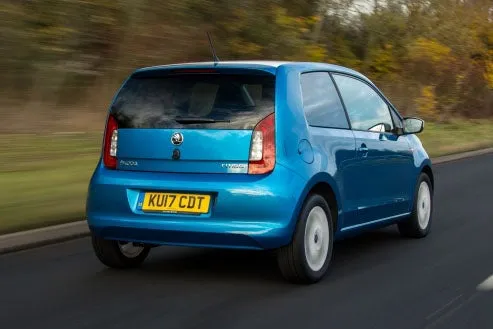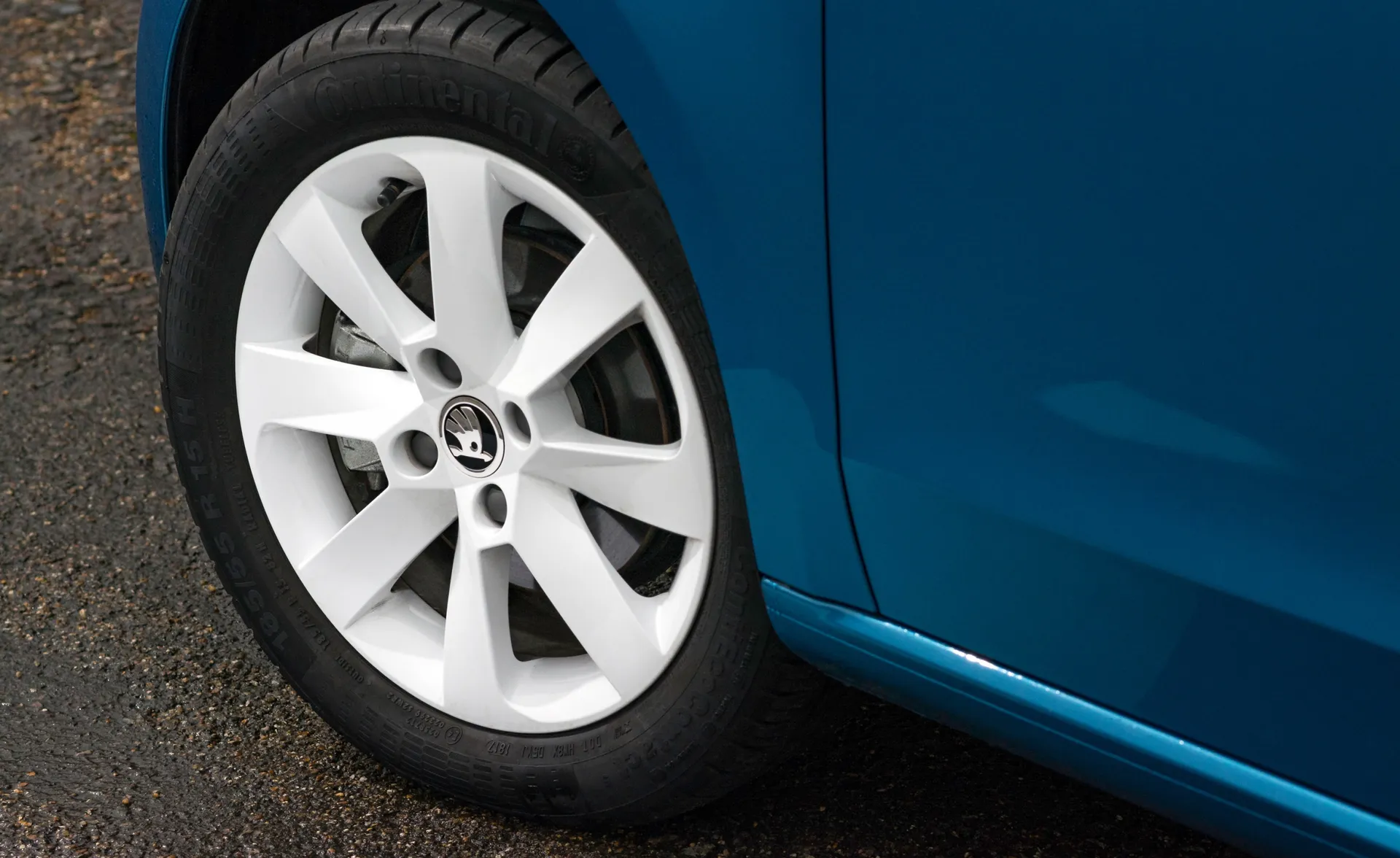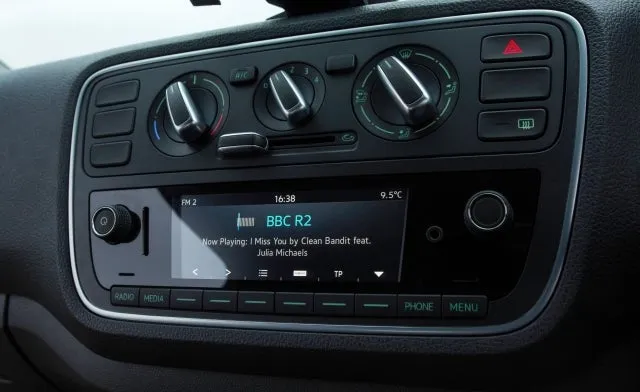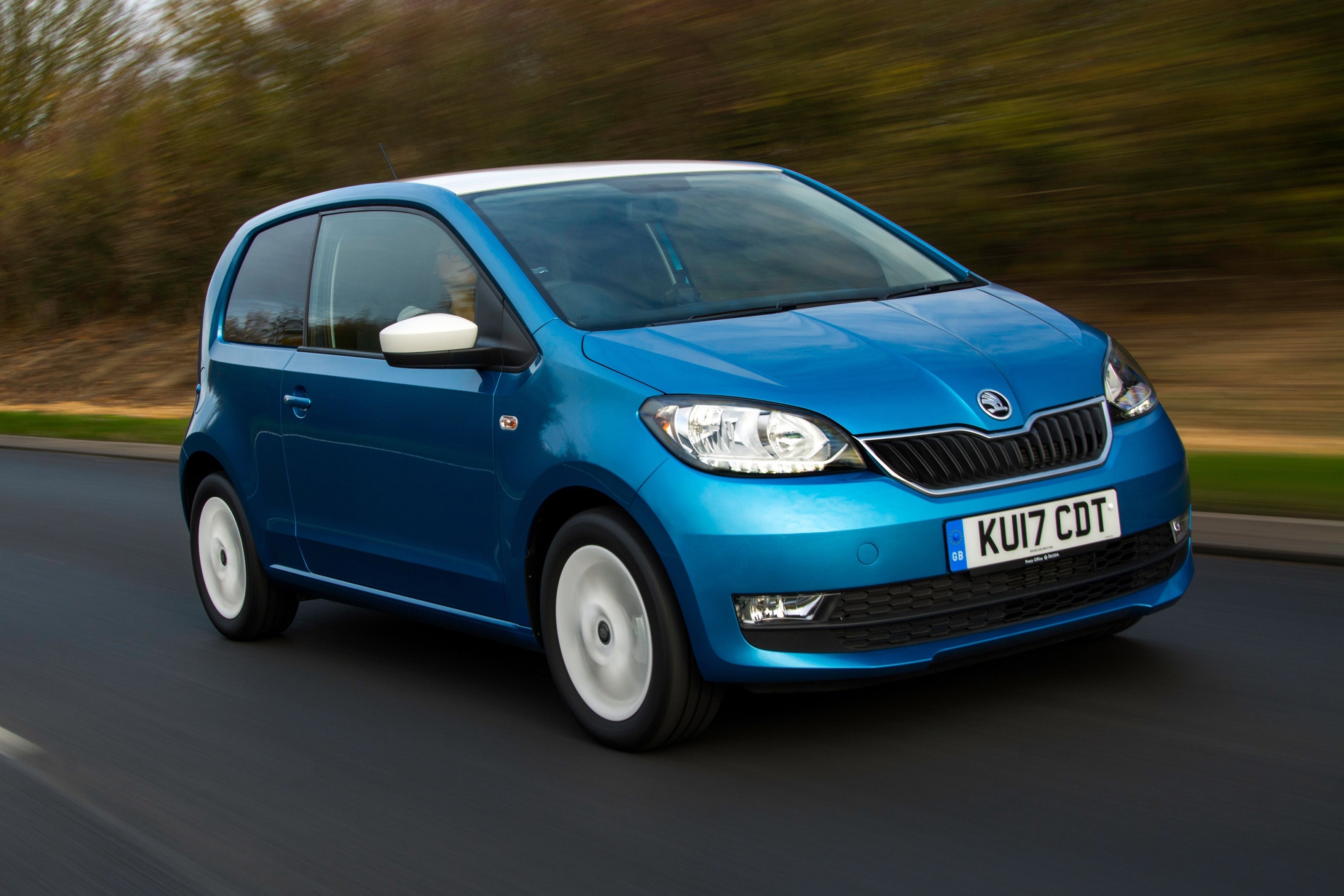Skoda Citigo (2012-2019) Review
Written by Andrew Brady
Quick overview
Pros
- A quality item despite the low price
- Comfortable ride
- Costs peanuts to run, low depreciation, too
Cons
- Rubbish automatic option
- 75PS engine on top-spec trim only
- No chance of three passengers across the back
Overall verdict on the Skoda Citigo
"As with the rest of Skoda’s output stretching back as far as the early 1990s, the Skoda Citigo was part of a joint project with Spanish brand SEAT and parent company Volkswagen, each of whom also launched a contender in the city car class at in the same period."

These brilliant city cars were created together to share the design and development costs to create something more sophisticated than the competition, with maximum cabin space and a grown-up feel, while still being easy to drive and cheap to run. How successful was it? Find out in our Skoda Citigo review.
The Skoda Citigo has the same body structure, mechanicals and basic interior layout as the Volkswagen Up and SEAT Mii, while the exterior is basically the same with some detail changes to distinguish the three. As is typically the way within the Volkswagen Group of brands, the Skoda take on things is to prioritise value, and frequently, the Citigo was the cheapest contender of the three when compared model-for-model.
You don’t have to be a car designer to understand the Skoda Citigo from the outside. It’s not a million miles from being a rectangular cuboid, with only the sloping windscreen and a slight curve at the top of the tailgate as a concession to good looks and aerodynamics. At the back, the near-vertical tailgate is ideal for maximising interior space, while the long roofline and short overhangs also contribute to maximum space efficiency. If that sounds like a recipe for a car you’d rather not spend too long looking at, don’t be fooled: there’s a chunky cuteness to the Skoda Citigo that's very appealing.
Simplicity is the order of the day on the inside, too, although that doesn’t mean it’s all doom and gloom in here. There’s a substantial glazed area to let in lots of light, while the sparse layout of the dashboard helps to boost the feeling of space.
The major controls are mounted centrally and high up by the driver. The instruments are also clear and attractive, with a handy trip computer in the bottom of the speedometer. It might not feel like you’re swimming in equipment, but what there is feels of good quality, which prevents you from feeling like you couldn’t afford a proper car.
Further cost savings are made in the engine department, which is reduced to two simple and almost-identical options. Both engines are 1.0-litre three-cylinder units, with a choice of 60PS and 75PS outputs, with a torque figure of 95Nm for both options.
There’s not a huge amount to choose between the two: they’re both free-spinning and willing companions, with very similar performance, fuel consumption and emissions. We’d suggest choosing the 75PS version if you can stretch to it, as the little extra performance is useful if you plan on hitting the motorway. Most versions are fitted with a five-speed manual gearbox, which is easy to use and has well-chosen ratios to suit city and out-of-town driving. An automated manual gearbox was also available as an option, but clunky and jerky gearshifts meant it wasn’t particularly popular.
The Skoda Citigo may be relatively old now compared to some of the competition, and it's no longer available as a new car, but as a used buy, its strengths remain: it’s easy to live with, easy to drive and very good value.
With your sensible hat on, the Skoda Citigo is the best option compared to the SEAT Mii and Volkswagen Up, because it offers almost all the same attributes but for less cash. It also more than stands comparison with rivals from other manufacturers, too, with strong abilities in almost every area.
Looking for a used car for sale? We've got 100s of Skoda Approved Used Cars for Sale for you to choose from, including a wide range of Skoda Citigo cars for sale. If you're looking for the small electric car version, you need our Skoda Citigo-e iV review.
Is the Skoda Citigo right for you?
It might be classed as a city car, but if you can fit all the people and luggage you need into a Skoda Citigo, then there’s a good chance it can fit into your life.
Whether you are a new driver that needs something small and easy to manage, or a small family that takes occasional longer distance trips, the Skoda Citigo has the breadth of ability that makes it able to tackle all of those tasks. The fact that it is one of the cheapest cars to tax, fuel and insure is a bonus for everyone.
Most of its rivals offer similar strong points - low running costs and a compact exterior are essentials for the city car class - but the Skoda Citigo manages to do all this while still feeling like a car for grown ups. The quality of the interior and the way it drives make it feel like a bigger car that’s been shrunk to fit, which is definitely a good thing.
What other cars are similar to the Skoda Citigo?
It goes without saying (but we’ll say it anyway) that the Citigo’s closest rivals are the Volkswagen Up and SEAT Mii, the former offering a bit more class and the option of a more powerful turbo engine on latter models, while the Mii is arguably a bit better looking but may cost a little more.
Another trio, this time the Peugeot/Citroen/Toyota triplets in the form of the 108, C1 and Aygo, offer a similar low-cost but big-value take on the city car. However, they are not quite as sophisticated to drive and not as nice to sit in. A top choice in the city car sector is the Hyundai i10, which isn’t quite as nice to drive but is more spacious inside and is well-built.
Comfort and design: Skoda Citigo interior
"The Skoda Citigo lures you in straight away with a good first impression as soon as you open the door, because the design and layout of the cabin is inviting, rather than instantly reminding you of how much money you haven’t spent."

It’s the work of a moment to get comfortable in the driver’s seat - all models except the basic S get height adjustment for the driver - and although the steering wheel only adjusts for height and not for reach, even taller drivers will find it easy to be in the right spot.
It’s just as quick to get a handle on the controls, too, with almost all the key buttons and switches sat high up on the dashboard in a neat group. It’s a similar story with the instrument display sat behind the steering wheel, with a large central speedometer containing a small trip computer and a pair of smaller secondary dials either side. It’s pleasingly simple and makes it easy for drivers of all experience levels to jump in and just get going.
The trim level you choose has significant bearing on how the cabin looks. Skoda Citigo S and SE models get variations on black and grey trim, which is of a decent quality but it doesn’t help the brightness of the cabin with so many dark-finished colours. The high-spec Elegance model comes with the option of an ivory finish and some special editions like the Monte Carlo have additional body colour elements dotted around the cabin, but it is a shame so many versions go for the coal-hole approach.
Quality and finish
The upside is that the Skoda Citigo covers itself in glory with a quality of finish that is beyond most of its rivals. This is still a cheap car remember, but it does an excellent job of hiding that fact from you as much as possible. It’s more obvious in the lowest specification S model, but even then the quality of the materials and the standard of build is good.
There are some cheaper plastics dotted around the cabin of course, but at least where they are present they feel like they will survive years of use rather than becoming easily damaged or broken. You can also feel the quality in the way that the switches operate with reassuring solidity: they feel like they’ve been pinched from a more expensive car, rather than being whatever was left in the parts bin.
As you move up the range things get more appealing, with a leather steering wheel fitted to the Sport and Elegance models, as well as selected special editions, and smarter trim on the seats, all of which help the feeling of quality.
Infotainment: Touchscreen, USB, nav and stereo in the Skoda Citigo
The infotainment setup in the Skoda Citigo changed during its production run, so what system you end up with depends on the model you choose, but also how old the car is.
From launch in 2012, S and SE models came with a basic FM/AM radio with CD player and auxiliary input as standard, while Elegance models and upwards had the Portable Infotainment Device (PID). This was a separate screen that fixed to the top of the dash and provided Bluetooth for streaming and phone calls, satellite navigation and a trip computer. It was a relatively inexpensive way of adding these functions to the car, although the fact that it is removable puts it at risk of theft.
Later models ditched this idea, with a different specification for each model. S trim gets a CD player with a USB port and twin speakers, while SE and above adds to this a colour display, four additional speakers and Bluetooth but removes the CD drive. The later system allows you to connect your smartphone - held in place by an integrated cradle - and use the dedicated app called Move&Fun, offering much the same features and a few more, but direct from your smartphone.
Of the two, the later system is preferable, as apart from anything it will benefit from regular updates and the ease of use. If you go for an earlier model, make sure the seller includes the PID if it was originally fitted.
Space and practicality: Skoda Citigo boot space
Even city cars as small as the Skoda Citigo have to provide space for passengers and luggage, and if anything they have to work harder than bigger cars to do so: with less room to play with, space efficiency is everything. The good news is that the Citigo is one of the best in the class in respect of interior space, despite only measuring 3597mm long and 1645mm wide.
Remarkably, almost any size of driver can get comfortable in the Skoda Citigo, even though the steering only adjusts for reach, with plenty of head- and legroom to stretch out. Shoulder room is good also, despite being a relatively narrow car. The feeling of space is boosted by the slim dashboard and the large glazed area, increasing the amount of light coming into the cabin.
In the rear, there is not quite as much space available, but it is still good for a car of this size. The rear seats are mounted slightly higher than those in the front, reducing the amount of headroom slightly, while legroom is reduced and dependent on the position of the front seats.
Even so, you can accommodate adults on shorter journeys, and all but the tallest children will fit relatively comfortably. Five-door models have easier access to the rear seats, but getting into the back of the three-door is not too difficult, either. It is important to note that the Citigo is a strict four-seater, with a rear bench designed for two and a pair of seatbelts rather than three, which may rule it out for some buyers.
The Skoda Citigo’s boot space is equally impressive, with a sizeable 251 litres available, putting it just behind the Hyundai i10 and ahead of the Renault Twingo and Toyota Aygo. Fold the rear seats, and this can be expanded to 959 litres, and there’s an adjustable boot floor, too, so you can hide more valuable items. S models get a single backrest, whereas SE and above get a 60/40 split seat, so you can carry more luggage and still have a rear passenger.
Storage space in the cabin is also impressive, with good-sized door bins that can hold a 1-litre bottle, a cubby in front of the gearlever - with an insert designed to hold a smartphone if you wish - plus a larger-than-average glovebox, all of which help make the car easier to live with.
All Skoda Citigo versions are fitted with a tyre repair kit as standard, but a temporary spare was available as an option, so if you are buying a used Skoda Citigo, it is worth enquiring whether this option was selected.
Handling and ride quality: What is the Skoda Citigo like to drive?
"The Skoda range is filled with cars that are low-stress, with a comfortable ride and secure handling, and even though it is comfortably the smallest car in the range, the Citigo hits the same standards."

It only takes a few miles behind the wheel to discover that the Skoda Citigo feels like a very mature car. It’s size means you’re always aware that it’s not a luxury saloon, but it never feels out of its depth even out of the city.
The steering is one of the best aspects of the driving experience. It’s light enough for low speeds and parking, but not too light to feel accurate, and there's decent feedback so you know exactly what’s going on with the front wheels. Whether you’re cruising or battling through urban traffic, the Skoda Citigo inspires confidence.
The ride quality is also another major plus point. Again, it’s not big-car comfortable because it has a short wheelbase, but it’s one of the best in the city car class, dealing with imperfections regardless of size, which is a real bonus in everyday driving. Be wary of models that get stiffer sports suspension, like the Sport and Monte Carlo, which does hurt the ride quality a little, so unless you plan to treat it like a little hot hatch, it would be best to avoid models fitted with this option.
It’s not really a necessary option because the regular Skoda Citigo handles with composure and assurance, plus as much fun as you could reasonably expect. The accuracy of the steering helps, and even with the softer of the two suspension setups, body roll is kept in check unless you’re really pressing on.
What engines and gearboxes are available in the Skoda Citigo?
The limited choice here means you can’t go very wrong. It’s a 1.0-litre, three-cylinder petrol engine regardless, you just get to choose between 60PS or 75PS outputs. There’s not much between the two, with identical claimed combined fuel consumption and CO2 emissions whichever version you choose.
The 60PS unit is willing and refined, and can still deal with motorway journeys, but if you can afford the 75PS version it makes life a little easier: it can hold a higher speed more comfortably and is a little quicker in acceleration terms, too.
The Skoda Citigo, like the SEAT Mii, was never available with the more powerful 90PS turbocharged unit that was offered in the Volkswagen Up, which is a shame. Later on, the Citigo was also offered as an all-electric car.
As with many of its rivals, the Skoda Citigo’s engines are all three cylinder, and while that means a fraction more noise than four cylinder offerings, it actually adds something to the driving experience. The three-cylinder unit spins happily away up front, and is happy to be revved to the stars if you feel so inclined, but it also allows you to cruise in a reasonably quiet and refined way.
As for gearboxes, the standard five-speed manual is all you’ll need. It has well-chosen ratios so it’s easy to get up to speed, yet can cruise comfortably on the motorway. The automatic offering is actually an electrically-operated manual, and while that sounds good, it actually spoils the driving experience, so avoid it unless you absolutely have to drive an auto.
Refinement and noise levels
For a car of this size and cost, the Skoda Citigo offers a level of refinement that is usefully above the class standard, and is big part of it being an easy car to live with. The fact that it is a well-built car helps significantly, with minimal vibrations finding their way into the cabin.
The three-cylinder engine may be a busy-sounding thing, particularly if you try to hurry it along, but it is actually a relatively refined unit. There’s virtually no difference in noise levels between the 60PS and 75PS versions, although you won’t have to work the more powerful version quite so hard.
At low to medium speeds, noise from other sources is kept well in check. Small wheels mean skinny tyres so tyre noise is reasonably low on most surfaces, while wind noise doesn’t present any problems. At higher speeds the latter starts to make itself known, but not unreasonably so. You can take on a lengthy motorway journey without having to stop frequently to give your ears a break.
Safety equipment: How safe is the Skoda Citigo?
The Skoda Citigo has been tested by Euro NCAP on two occasions, once when the car was first introduced in 2011, and again in 2019 when it was relaunched as a pure electric model. It’s also important to note that it was actually the Volkswagen Up that was tested, as Euro NCAP decided the amount of identical design and equipment meant a separate test was not required.
In the 2011 test the Citigo scored an impressive five stars. It achieved 89 per cent for adult protection and 80 per cent for child protection, and although pedestrian mitigation was quite low at 46 per cent - a result of being such a short car - it managed a high 86 per cent for safety assist. Standard equipment includes front- and side airbags, seat belt pretensioners and load limiters, ISOFIX child seat mounting points, hill hold assist and tyre pressure monitoring.
On early Skoda Citigo models, all versions except the S were fitted with ESC stability control as standard, but it could be added as an option, along with City Safe. The City Safe was optional on the rest of the range, too and was Skoda’s name for Automatic Emergency Braking, so is a worthwhile addition if you can find a car with it fitted. Later Skoda Citigo models had ESC as standard across the range, while City Safe remained an option on all models, so check the specification carefully when looking at a used car.
MPG and fuel costs: What does a Skoda Citigo cost to run?
"One of the main reasons for choosing a Skoda Citigo is the low fuel consumption. Measured by the old NEDC economy system that was in effect when the car was new, the Citigo range claims between 62mpg and 68mpg combined under official figures."

In the real world, you should expect to beat 50mpg with little effort, and possibly over 60mpg if you drive the right way. The automated manual gearbox uses a bit more fuel, which is another reason to give it a miss.
Skoda offered the Skoda Citigo in Greentech form on SE and Elegance models, which added stop/start, lowered suspension and low rolling resistance tyres. It does improve the economy a little, but this was originally intended to get the car below the 100g/km CO2 threshold, so this only provides a worthwhile benefit if the car is old enough to qualify for zero VED.
How reliable is the Skoda Citigo?
The Skoda Citigo has been around for well over a decade now, and the good news is that it's proved to be a very reliable city car, with no major common problems reported.
Skoda as a brand performed okay in the latest HonestJohn.co.uk Satisfaction Index, ranking 13th overall out of 29 manufacturers, which is about as fair-to-middling as you can get.
Insurance groups and costs
Top marks for the Skoda Citigo here, as it manages to get the entire range into either 1E, 2E or 3E insurance groups, helped by the good provision of safety equipment. That means premiums that won’t necessarily reach tens of thousands if you’re a new driver: it’s definitely one of the best first cars for new drivers because of this.
Older and more experienced drivers can enjoy insuring their Skoda Citigo for as little as possible, alongside fuel bills that are amongst the lowest in the class. It's certainly one of the cheapest cars to insure.
VED car tax: What is the annual road tax on a Skoda Citigo?
As with its Volkswagen and SEAT siblings, the Skoda Citigo can be free to tax or cost considerably more than that depending on the version you choose but more importantly the age of the vehicle. All versions of the Citigo with a manual gearbox come under 100g/km, so if they are registered before April 2017 they qualify for zero road tax. Cars from April 2017 and onward automatically jump to £190 a year, whether you go for the manual or automatic transmission. But choose the manual...
How much should you be paying for a used Skoda Citigo?
"With almost ten years of production, and immense popularity over those years, there are plenty of used Citigos on the market."

The last of the petrol-powered versions were new in 2019, and thanks to its popularity there are still plenty of versions available with very few miles on the clock. A quick search of the heycar classifieds turned up dozens of examples at around the £6,000 mark. These are around eight years old, because that's the oldest we stock, and the vast majority had done less than 50,000 miles. That's a lot of car for the money.
If you want something a bit newer, we found a late 2019 car with just 10,000 miles under its wheels in tempting Colour Edition spec for less than £9,000.
Trim levels and standard equipment
On the earliest Skoda Citigos we would suggest skipping the basic S trim, as although it might make for a cheap car, it was not massively popular because it had so little equipment. Far better to go with an SE model as the minimum standard, which was much more popular with buyers so you get more choice, and adds important things like air conditioning and ESC.
As for latter Skoda Citigos, S models do get ESC but still do without air conditioning, whereas SE models get alloy wheels and the upgraded audio system including Bluetooth, which are welcome additions. The Colour Edition models add visual elements and bigger alloy wheels, but for a high-spec car we would recommend the Elegance (later called SE L), which adds rear parking sensors, smarter interior trim and heated front seats.
Ask the heycar experts: common questions
Is the Skoda Citigo a good car?
Is the Skoda Citigo same as Volkswagen Up?
Does Skoda Citigo have air conditioning?
What engine is in the Skoda Citigo?
Get our latest advice, news and offers
Keep me updated by email with the latest advice, news and offers from heycar.
By submitting you agree to our privacy policy




